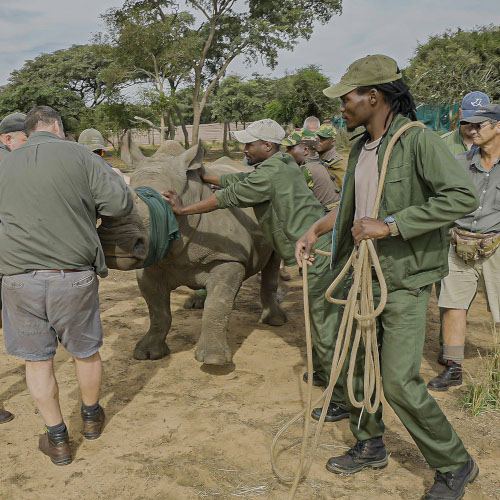Jan 03 | 2024
Heavyweight Move Promotes Long-term Conservation in Africa
_1.jpg) By Malcolm Ramsay
By Malcolm RamsayAir Charter Service was recently called on to support the reintroduction of 16 southern white rhinos to a nature reserve in the Democratic Republic of the Congo. ACS’ Lyndee du Toit describes the meticulous planning and specialized equipment required to transport these hefty jetsetters!
From Issue 1, 2024 of Breakbulk Magazine.
Every breakbulk project presents its own set of unique challenges, requiring expertise and careful planning. However, when it comes to the transportation of living animals, the complexity of the project can increase exponentially. This is compounded when those animals are being introduced to a new habitat after an absence of over a decade.
This is the scenario that aviation logistics specialist Air Charter Service, or ACS, encountered when it was called upon to assist in the reintroduction of rhinos to a nature reserve in the Democratic Republic of the Congo, or DRC.
In collaboration with non-profit conservation organization African Parks, and a range of local and international partners, ACS oversaw the successful breakbulk delivery of 16 southern white rhinos to a nature reserve in the northeast of the DRC in 2023, heralding a new era for the park as the animals repopulate the lands of the now extinct northern white rhino.
“The last northern white rhino was poached in the DRC in 2006 and this project, arranged by African Parks, is part of a ground-breaking effort to restore the ecological balance of one of Africa’s oldest national parks,” Lyndee du Toit, managing director of ACS Africa, explained. “We were contacted by African Parks to source a suitable solution for the transportation of 16 rhinos from Phinda Private Game Reserve in South Africa to Garamba National Park in the DRC.”
This breakbulk move not only required meticulous planning and specialized equipment to ensure the speedy transportation of these magnificent animals within a restricted timeframe, but safety was also a top priority with security concerns adding further complexity.
“Due to the high value and risk associated with transporting rhinos, we had to ensure suitable armed security was provided,” a spokesperson for ACS’ local freight forwarding partner commented.
Careful Pre-planning
The project was part of a wider initiative that stems back decades. Spanning over 5,000 square kilometers of savannah and equatorial forest, with almost 10,000 square kilometers of adjacent domaines de chasse, or hunting grounds, Garamba is one of Africa’s oldest national parks, and was declared a UNESCO World Heritage Site in 1980.
Throughout its recent history Garamba National Park has faced significant challenges, including armed conflict, ivory poaching, and civil wars that threatened its wildlife and UNESCO listing. African Parks and Institut Congolais pour la Conservation de la Nature, or ICCN, began collaborating to manage the park in 2005 but immediately faced security issues due to the rebel group, Lord’s Resistance Army (LRA), and other armed forces operating in the region. In 2006, the last northern white rhino was poached, and this breed has since become functionally extinct as a sub-species.
In 2016 the partners revised their approach to park management, and following the cessation of armed conflict, they implemented new systems to improve conservation enforcement and bring stability. As part of this new approach a plan was developed to bring southern white rhino to the area.
Peter Fearnhead, CEO of African Parks, reflected on the significance of this delivery of southern white rhinos to the park, stating that efforts to save the northern white rhino “were a case of ‘too little too late’ and should never be allowed to happen again.”
“Now that Garamba is a safe location and has proper protection in place, this reintroduction is the start of a process whereby southern white rhino, as the closest genetic alternative, can fulfil the role of the northern white rhino in the landscape.”
To ensure the timely delivery of this valuable cargo, the need for air cargo was quickly recognized and ACS, working with its local partners, began a careful process, examining all available options and routes.
“When planning the transportation, we had to carefully consider the routing to ensure we met requirements for BMA / CITES permits and inspection, as well as consider fuel and tech stops along the way,” the spokesperson for the local freight forwarder commented. “Transportation to and from the points of exit/entry was another important aspect, factoring in road quality, borders, corruption and potential conflicts.”
Having identified the key risks, a route to fly the rhinos directly from South Africa to the park was created and the team were then able to pick the ideal aircraft for the job, selecting a Lockheed L-100 Hercules.
“We decided that a Hercules L-100 would be the best fit for the job, largely because of its ability to land on short, dirt runways,” du Toit of ACS told Breakbulk. “The rear-loading capability of the Herc was also utilized as [the] airstrip in north-eastern DRC didn’t have sufficient equipment to assist in offloading the rhinos.”
Transcontinental Delivery
The rhinos to be transported were sourced from &Beyond Phinda Private Game Reserve in South Africa. Located in the eastern coastal province of Kwa-Zulu Natal (KZN), within the Mun-Ya-Wana Conservancy, the reserve is a sanctuary for numerous rare species, including the southern white rhino.
 “Conservation translocations have been proven to be a critical tool in securing the survival of endangered species, such as the rhino,” said Dale Wepener, &Beyond Phinda conservation manager. “Creating new habitats and ranges is something that &Beyond has been doing for a while, especially through our history of moving rhino from Phinda to other parts of Southern Africa. We believe that this latest conservation translocation and introduction is a way of protecting the species by creating a new, safe and secure habitat for the species.”
“Conservation translocations have been proven to be a critical tool in securing the survival of endangered species, such as the rhino,” said Dale Wepener, &Beyond Phinda conservation manager. “Creating new habitats and ranges is something that &Beyond has been doing for a while, especially through our history of moving rhino from Phinda to other parts of Southern Africa. We believe that this latest conservation translocation and introduction is a way of protecting the species by creating a new, safe and secure habitat for the species.”Having been considered extinct in the late 19th century, a small population of fewer than a hundred southern white rhino was discovered in 1895 and though conservation efforts have now expanded this population to several thousand, the species remains classified on the IUCN Red List as Near Threatened.
“This reintroduction forms part of the overall strategy to promote the long-term conservation of white rhinos in Africa by extending their range and creating new breeding nodes for the species in secure areas,” Fearnhead added.
Exceptional Requirements
Given the delicate state of this population, each of the 16 rhinos to be transported was treated with the greatest care and required in depth arrangements to ensure they arrived in the best of health.
“Container design and dimensions were carefully considered to comply with International Air Transport Association Live Animals Regulations and provide a suitable environment for the rhinos during the flight,” the local freight forwarding team leader noted. “We also had to address the transportation of drugs and medicaments required for the rhinos, ensuring their legality and responsible handling.”
As with any international breakbulk move, the correct customs and airway bill documentation had to be provided but in this case a range of additional checks and certifications were also needed, including pre-export microchip verification from the South African Department of Forestry, Fisheries, and the Environment.
“Defining responsibilities for permits, VHCs, and inspections was crucial to ensure compliance,” the team noted, adding that “flight dates and times were carefully chosen to consider animal welfare and personnel safety.
“We also made sure to include drugs, palletizing materials, and other often overlooked items such as laptops, cellphone chargers, and protective gear. Additionally, we provided suitable clothing, sun-protection, and extra provisions of oxygen, food, and water for both the rhinos and the handlers during the flight.”
This attention to the health and wellbeing of the animals also created some logistics challenges for the partners involved in the move as the size of the aircraft limited the number of rhinos that could be packed onboard.
“Using [the L-100) meant that two flights were needed, as each rhino weighed around two tons or more,” du Toit explained. “Through careful planning, we were able to perform both flights in the same week, with both being loaded at night and both arriving at first light in Kibali.”
Long-term Success
.jpg) With the cargo carefully delivered, the rhinos were then unloaded at the Kibali Mine airport strip, operated by mining firm Barrick Gold Corporation, a key sponsor and partner in the project. A long-standing partner with African Parks, Barrick Gold Corporation is a lead donor in the translocation project and to date has provided more than US$2.5 million for tracking collars, fuel for observation planes, rescue and rehabilitation programs as well as improvements to critical infrastructure such as roads and bridges.
With the cargo carefully delivered, the rhinos were then unloaded at the Kibali Mine airport strip, operated by mining firm Barrick Gold Corporation, a key sponsor and partner in the project. A long-standing partner with African Parks, Barrick Gold Corporation is a lead donor in the translocation project and to date has provided more than US$2.5 million for tracking collars, fuel for observation planes, rescue and rehabilitation programs as well as improvements to critical infrastructure such as roads and bridges.President and CEO of Barrick Gold Corporation, Mark Bristow, noted that the funding for this move “stems from our 10-year partnership with African Parks” and is a key part of ongoing investment in the conservation of Garamba National Park, adding that “biodiversity underpins many ecosystem services on which our mines and their surrounding communities depend.”
To ensure that the impacts of this translocation are long-term and that the rhinos are able to integrate and breed in their new home successfully, the partners also oversaw delivery of vital equipment required for this new population.
“We ensured follow-up and checks were conducted to ensure the success of the transportation,’ the team noted. “In terms of equipment, we provided crane trucks, straps, extra spreaders, and wooden blocks to assist with the handling of the rhinos.”
Praising the teamwork of all involved, Bristow said: “Being able to play a role in protecting biodiversity and preventing nature loss is central to what we do,” adding that the partners all plan to continue working to “achieve economic, socio-political and ecological sustainability.”.
Africa’s burgeoning project market will be the focus of a main stage panel session at Breakbulk Middle East 2024 in Dubai. The session, sponsored by CEVA Logistics, will take place on Tuesday 13 February from 13:35–14:20.
PHOTO CREDIT: Martin van Rooyen
